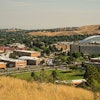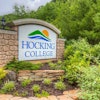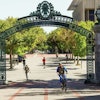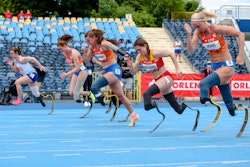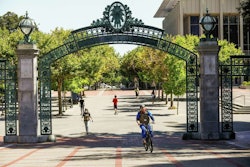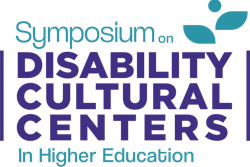Assistive Technology Comes Into FocusWith the push from federal legislation, colleges and universities enhance learning for the disabledAccess in higher education is usually understood as the admission, financing, and social support of students belonging to socially disadvantaged groups as they pursue postsecondary education. However, that understanding has focused largely on students from racial and ethnic minority groups and on those who hail from low-income families. As a result, attention to access for the disabled has tended to be obscured by the publicly contentious issues around race, ethnicity and class.
It is estimated that between eight to 12 percent of students in American higher education have disabilities that require special attention. The last three decades have seen colleges and universities develop resources and facilities that accommodate the needs of disabled students. Federal statutes going back to the 1970s and the 1990 Americans with Disabilities Act legislation have played a critical role in pushing schools to make their campuses physically accessible and to have trained personnel to work with disabled students.
Nonetheless, the decade of 1990s, with the explosion of the Internet, has ushered in demands that higher education accommodate students with what is known as assistive technology. The term, assistive technology, refers to technology that is information- and media-oriented. Higher education experts note that while American colleges and universities have aggressively enhanced courses and campus communication with Web sites, they have paid too little attention to making the technology accessible to students with disabilities.
“In higher education, access problems tend to revolve around the computer. Typically, disabled students have their mobility issues worked out. They have their communication devices. And they’re able to take care of the environmental controls (in their residential setting),” says Marla Roll, director of the Assistive Technology Resource Center at Colorado State University.
“I feel like accessibility is an afterthought when it comes to technology. (Schools) don’t think about technology on the front end,” she says. Assistive technology professionals including Roll point to a recently enacted federal law expected to boost the use of assistive technology on campuses. In the summer of 2001, federally enforceable regulations took effect mandating that all “EIT” (electronic and information technology) developed by federal agencies and federally affiliated institutions and organizations be accessible to persons with disabilities. All of the nation’s colleges and universities fall under the domain of the new standards contained in the Section 508 amendments to the Rehabilitation Act of 1973, according to a consensus of higher education experts.
Enacted in the Workforce Investment Act of 1998, the Section 508 amendments prescribe new standards for six areas of technology:
• Software applications and operating systems.
• Web-based information or applications.
• Telecommunication products.
• Video or multimedia products.
• Information appliances, such as fax
machines and kiosks.
• Desktop and portable computers.
Since the 1980s, colleges and universities have gained experience with making hardware, such as computers with voice recognition technology and other special devices, available to disabled students. But institutions are less experienced with creating Web sites that can be interpreted for the disabled by special devices.
The challenge for colleges and universities is to upgrade campus Web sites and course management software systems to make them readable by the devices that disabled students use. For example, a Web site accessible to a blind student has to be designed so that equipment known as a screen reader can read and describe aloud the text and visual images on a Web page.
Campus IT specialists say the legacy of highly decentralized Web publishing in higher education presents a significant obstacle for schools attempting to make their Web sites accessible to the disabled. During the mid-1990s, institutions facilitated campus Web site development by allowing individual faculty members and departments to design their individual Web pages with little central oversight, little to no standardization and differing Web software platforms, according to IT experts. MEETING THE NEEDS
Assistive technology professionals have recognized that among the dilemmas needing major attention is the training of college and university staffers who work in their school’s office for disability services. Typically, a school will have set up a single office to handle the disability issues on that campus and that office has to coordinate its activities with academic departments and the campus computing office.
“You find a lot of people in accommodations who don’t know much about technology,” says Kirk Behnke, training coordinator of the Center on Disabilities at the California State University at Northridge (CSUN). “The need has been there all along,” he adds.
At CSUN, Behnke and other officials have developed a certificate program to train disability services professionals within higher education as well as anyone who’s involved with the disabled in assisitive technology. More than 1,300 people from around the United States and the world have earned certification.
Annually, some 4,000 people attend the “Technology and Persons With Disabilities” conference sponsored by CSUN.
“Because of Section 508, people are looking at accommodations more than ever,” Behnke says.
A number of universities have distinguished themselves in research related to technology for the disabled. The University of Pittsburgh, which has close ties to the wheelchair industry, is one such school.
Other schools, like CSUN and George Mason University in Fairfax, Va., have made strides with research centers that develop educational programs and services for the disabled and the people who work with the disabled.
George Mason’s Helen A. Kellar Institute for Human disAbilities is one such specialized research center that develops products, services and programs for the disabled. The institute, which started out as the Center for Human Disabilities in 1988, works with 37 Virginia counties and other Virginia colleges and universities. With the institute hosting many of the school’s disability services, George Mason has been recognized as a model school on accessibility issues.
Dr. Michael M. Behrmann, director of the institute, says university and colleges struggle with getting their existing disability services staff acquainted with assistive technology, as well as finding new employees who have that experience. George Mason works closely with other Virginia colleges to train staff and provide expertise on disability issues.
“These schools need more people trained in assistive technology,” Behrmann says. ADVOCACY COUNTS
In addition to developing training initiatives for disability service professionals, the assistive technology specialists typically have to play the role of advocate, or activist, at their university and in their college and university systems.
“There is awareness at the grassroots level,” CSUN’s Roll says, noting that specialists like herself have to spend considerable time educating senior administrators on disability issues, such as assistive technology.
At CSUN, Roll is in an unique position as a faculty member in the occupational therapy department because she heads a center that uses students to develop accessibility solutions for disabled students.
One particularly demanding situation in recent years arose when a blind student majoring in equine science had to complete a horse-riding course that required her to ride a horse through an obstacle course.
When it came time for the student to navigate her horse through the course that included jumps, students in Roll’s center designed a system that alerted the blind rider with auditory cues as she approached various obstacles.
Roll reports that being in an academic department poses a challenge for their profile as a campus resource. The center conducts training workshops, solves access problems, and promotes awareness of access requirements. “The downside of being in an academic department is that we get lost and people don’t know we exist,” she says.
To that end, her department works closely with the campus computing services department at CSU. “I get good support from central computing,” she says.
Laurie Vasquez, like other assistive technology professionals active in higher education, has seen her job grow from one of solely handling matters at her campus to becoming an adviser and consultant to state commissions and community college organizations. Vasquez, who has become a leading expert on making distance education accessible to the disabled, is an assistive technology specialist at Santa Barbara City College in Santa Barbara, Calif.
“A lot of the intervention takes place at the local level. Those teachers deal with the students and see the need,” she says, noting that it often falls upon the instructors and the specialists to push their schools to be proactive on assistive technology.
© Copyright 2005 by DiverseEducation.com

